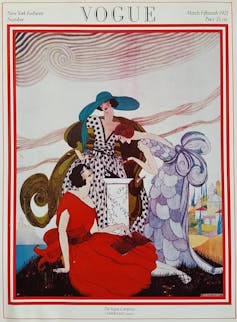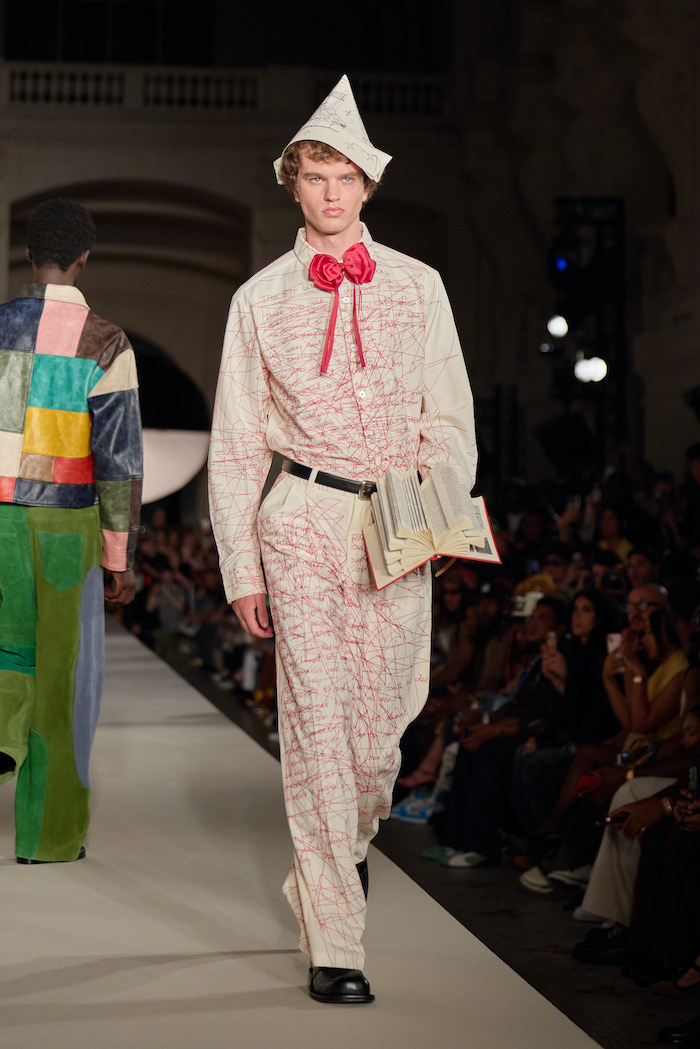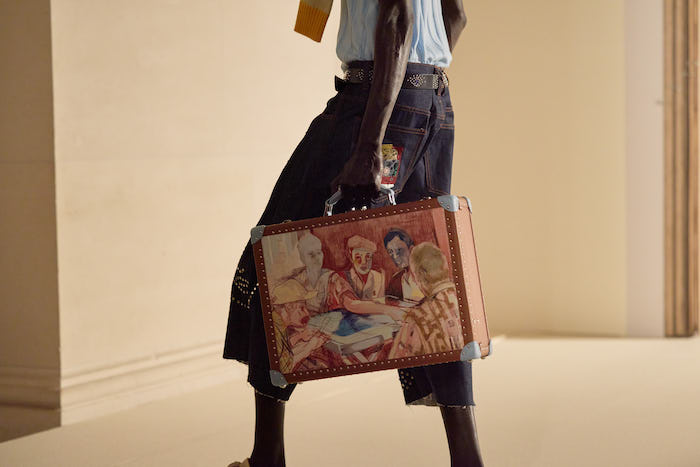 |
| KidSuper's show at the Louvre was greeted with rapturous applause by a star-studded front row of musicians and athletes. Photograph (above) and cover picture by Jay Zoo for DAM |
In Paris, Colm Dillane didn’t just present a fashion show at the
Louvre he launched a storybook. For his Spring/Summer 2026
KidSuper collection, The Boy Who Jumped the Moon, the designer transformed the
historic Musée des Arts Décoratifs into a surreal stage of towering books with turning pages. The American designer blended storytelling, childhood
fantasy, and fine tailoring into Paris Fashion Week's most imaginative
production, a celebration of risk, wonder, and the art of dreaming big, writes Jeanne-Marie Cilento. Photography by Jay Zoo
 |
The towering storybook on the stage of the SS26 Kidsuper show at the Louvre. |
UNDER the vaulted nave of the Musée des Arts Décoratifs, tucked
inside the majestic Louvre, Colm Dillane presented his most ambitious
KidSuper collection to date, a theatrical and wildly imaginative production
titled
The Boy Who Jumped the Moon.
With the verve of a Broadway show and the
intimacy of a bedtime story, Dillane’s Spring/Summer 2026 runway blurred the
lines between fashion, narrative, and dreamscape. It was a show not simply to
be watched, but experienced. Dillane, the Brooklyn-based creative force behind KidSuper, fuses his youthful irreverence with thoughtful artistry. This collection marks a significant moment in KidSuper’s evolution. From its origins as a small label specializing in hand-printed T-shirts, the brand has matured into a multidisciplinary creative powerhouse. The new show exemplifies how Dillane blends art, fashion, music, and sport into a cohesive vision.
This season’s runway was held beneath those soaring ceilings of the Musée des Arts Décoratifs, itself a repository of decorative arts and culture, in the Pavillon de Marsan at the northwestern wing of the Louvre Palace. Once part of the Tuileries and reconstructed after the Paris Commune, the venue added layers of cultural resonance to the show’s themes of reinvention and aspiration. The historical grandeur set the stage for Dillane’s mix of the whimsical and engineering feats, reflecting the collection’s themes of childhood wonder, risk-taking, and invention. "I think Paris is really good for platform for me to be able to do this because it elevates everything," he commented just hours before the show. "And we're here in the Louvre building, which is incredible."
"It's based around a children's book and the story is about trying for something and then it going wrong. But you figure it out and learn some magic on the way, so in the end you're satisfied with the journey"
 |
The cover of Colm Dillane's fable that the collection is based on. |
Upon arrival, guests found a children’s book on their seats, written and illustrated by the designer. A fable about a boy who, defying gravity
and grown-up logic, builds a contraption to fly to the moon.
"It's all based around a children's book and the story is basically about trying for something and then it going wrong," explains the designer, standing on the set at the Louvre. "But you figure out and learn some magic on the way, so in the end you're satisfied with the journey and trying things rather than a set, specific goal."
The runway was
framed by dizzyingly tall books that told the unfolding tale. As actor and television host Craig Ferguson narrated
from loudspeakers, models emerged from hidden slits in the pages, stepping
out like characters come to life. In one instance, a staircase was wheeled
forward so a model could descend from the sky, storytelling had become
stagecraft. The choreography was complex, a feat of engineering and theatre that underscored Dillane’s interdisciplinary approach to fashion shows.
The production itself was a logistical marvel. The three-story-high storybook set required seamless coordination among page turners, models, and stagehands, with multiple hidden exits and movable staircases enabling models to emerge from various points. Backstage, Dillane acknowledged the challenges but remained undaunted, viewing the complexity as part of the creative journey, "I like trying hard, I like going for it, I like shooting for the moon, and that's what this is about. And so, if it fails, it fails but if it works, it's amazing."
With the verve of a Broadway show and the intimacy of a bedtime story, Dillane’s Spring Summer 2026 runway blurred the lines between fashion, narrative, and dreamscape
 |
KidSuper's Colm Dillane backstage with a piece that has been designed with burn mark designs that tell the story of his children's book. |
The concept was more than just spectacle. It was an earnest exploration of
what it means to dream with abandon. "The most fun part is coming up with the concept and trying to figure out different ways to change what is a runway," he said. "So I sketched it all and this is my idea and now I have to make it real which was not so easy."
The clothes themselves are rich with metaphor. A navy wool
coat painted with an evening sky, a sun-yellow spacesuit, and a leather bomber
emblazoned with the story’s book cover formed part of the collection’s literary language. Dillane also incorporated new techniques and materials into the collection. "We have one jacket made of oranges," the designer said. "And we are doing a lot of 3D printing and different dye techniques, interesting because they are all based on the artwork of the book."
A jacket charred at the seams, a suitcase blown open
mid-journey, each piece read like a sentence in a fantastical tale. Details nodded to vintage school uniforms and bedtime stories, with pieces that incorporated sketches, handwritten script, and illustrations drawn directly from the book. Some garments included burn marks and scuffs, telling tales of crash landings and trial by fire, while others shimmered with embroidered constellations, lending a poetic touch to utilitarian shapes. Dreamy illustrations scribbled across
tailored silhouettes, Bermuda shorts made to resemble the ruled
pages of a school notebook, a painter’s ensemble, the apron
splashed with colors as though mid-brushstroke. Storybook surrealism met
streetwear in classic KidSuper fashion.
"I like trying hard, I like going for it, I like shooting for the moon, and that's what this is about. And so, if it fails, it fails but if it works, it's amazing"
 |
The Mercedes-Benz CLA specially custom-designed by Colm Dillane. |
The collection wasn’t just an ode to imagination;
it was also a vehicle, literally for collaboration, including Puma and Mercedes Benz and even Papa Johns. In the foyer of the museum, guests were greeted by a Mercedes-Benz CLA unlike any seen before: reimagined by
Dillane as a flying machine plucked from a child’s sketchbook.
Part of
Mercedes’ “Class of Creators” program, the vehicle sported turbine wings,
helium balloons ready to take flight, a roof rack stacked with vintage luggage, and even a
chrome-slingshot, recalling Dillane’s own childhood. It was both superhero
gadget and nostalgic dream machine, a Hot Wheels fantasy rendered in life-size
proportions.
KidSuper’s signature “Kissing Face” was stitched into the design, bridging the gap between mechanical innovation and personal storytelling. This vehicle wasn’t just a prop; it was the physical embodiment of the show’s spirit of imagination. That car gave rise to a capsule collection of ready-to-wear pieces, an industrial-chic tribute to automotive history filtered
through Dillane’s playful lens. Think jumpsuits, quilted bomber
jackets inspired by early 20th-century mechanics, and accessories that
straddled the line between pit crew utility and art object.
The result was a
gritty-yet-whimsical mashup of engineering and artful expression. Then came the curveball: a bag created with Papa Johns, inspired by the pizza chain’s new Croissant Pizza (a culinary hybrid sure to
ruffle French feathers), the collaboration yielded a delivery bag turned
couture conversation piece. It was a tongue-in-cheek nod to KidSuper’s ability
to locate art in the everyday ~ even in fast food.
"The most fun part is coming up with the concept and trying to figure out different ways to change what is a runway; I sketch it all and then have to make it real which is not so easy"
 |
Italian football star Mario Balotelli walked the runway at the KidSuper show. |
But as otherworldly as the show was, there was always a sincere throughline. Beneath the theatrics, beneath the ballooned cars and hand-drawn jackets, was a message about the power of belief: in stories, in collaboration, in oneself.
Dillane, now commands one of the most anticipated runways on the Paris calendar. And he’s done it without surrendering to fashion’s often rigid seriousness. Instead, he has leaned into humour, curiosity, and collaboration and community.
The casting reflected those ideas too. Italian footballer Mario
Balotelli closed the show in a patchwork bomber jacket and cargo pants, a
walking embodiment of the KidSuper ethos: unexpected and memorable. This was a nod to the designer’s passion for the sport. Balotelli’s presence added a real-world edge to the otherwise fantastical narrative, grounding it in the contemporary culture of sport and celebrity.
Colombian rapper Ryan Castro and a host of celebrity guests,
including French Montana and 2 Chainz, sat in the audience, sharing the show across their social media. The entire event had a real buzz of energy and excitement The show attracted a vibrant crowd of industry insiders and celebrities, including rappers and athletes. The vibe spilled into the evening’s after-party, where the spirit of collaboration and celebration continued, fueled by Dillane’s ongoing drive to push creative boundaries.
From Brooklyn to the Louvre, Colm Dillane has proved again that the distance between art and fashion, dreams and reality, is not so far after all: sometimes, all it takes is one well-timed leap of faith
 |
The show's set design was a feat of imagination and engineering. |
Technically, the complex show was a feat. The page-turning
stagehands, synchronized entrances, and soundtrack that moved from narration
to orchestration all worked like clockwork, any issues ironed out during the rehearsal.
With this
production, Dillane didn’t just show his collection, he evoked a special world he has created, one where he tells stories though his designs, where collaborations become his community, and where even
a pizza bag can be a work of art. It’s fashion, yes, but it’s also theatre, publishing, and performance.
Looking ahead, Dillane’s ambitions seem boundless. With plans to expand the children’s book into a larger publication and a growing roster of partnerships across different industries, KidSuper continues to challenge the conventions of fashion presentation and brand collaboration. In a world where the fashion runway often feels predictable, The Boy Who Jumped the Moon offered a reminder that creativity thrives on challenges, imagination, and the willingness to take flight even when the landing isn’t guaranteed.
Dillane doesn’t just
encourage risk, he celebrates it. He invites his audience, like his young
protagonist, to believe that jumping into the unknown is worth it. And for a fleeting moment, beneath the ceilings of one of
the world’s most revered museums, it felt like anything really was possible. From Brooklyn to the Louvre, Colm Dillane has
proved again that the distance between art and fashion, dreams and reality, is
not so far after all. Sometimes, all it takes is one well-timed leap of faith.
Scroll down to see more highlights from the KidSuper Spring/Summer 2026 show:


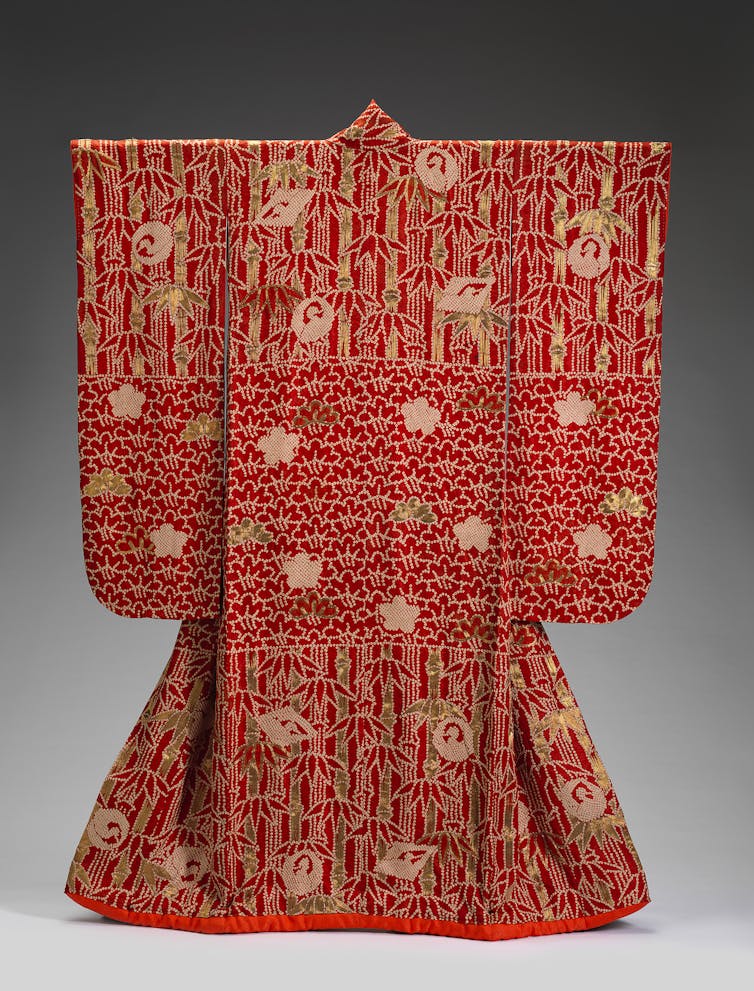
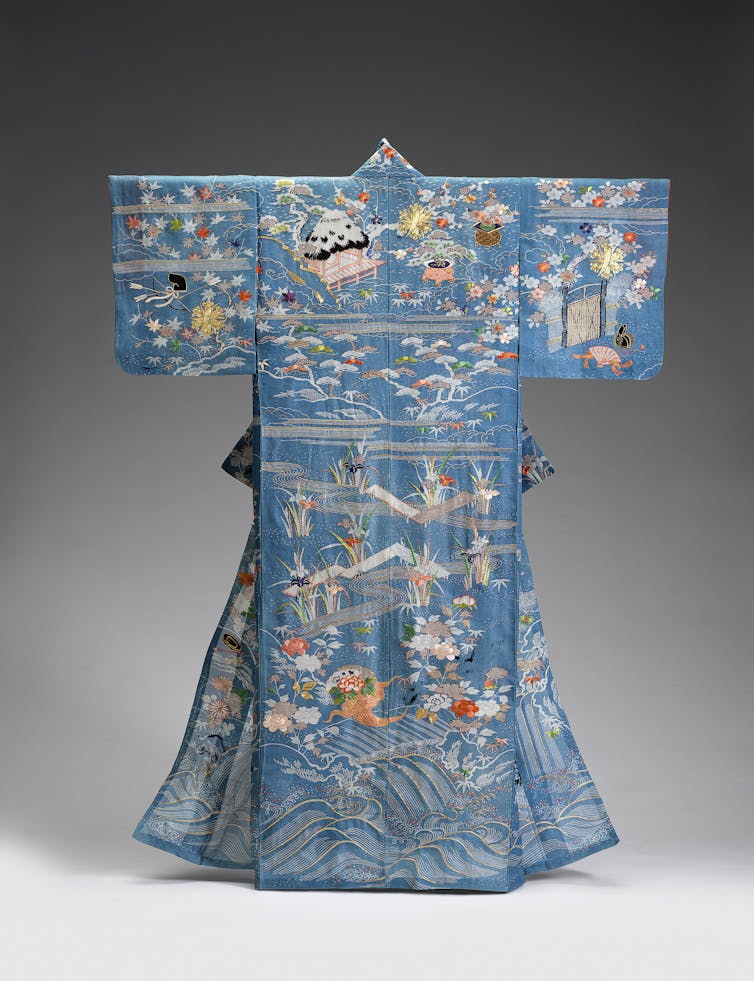
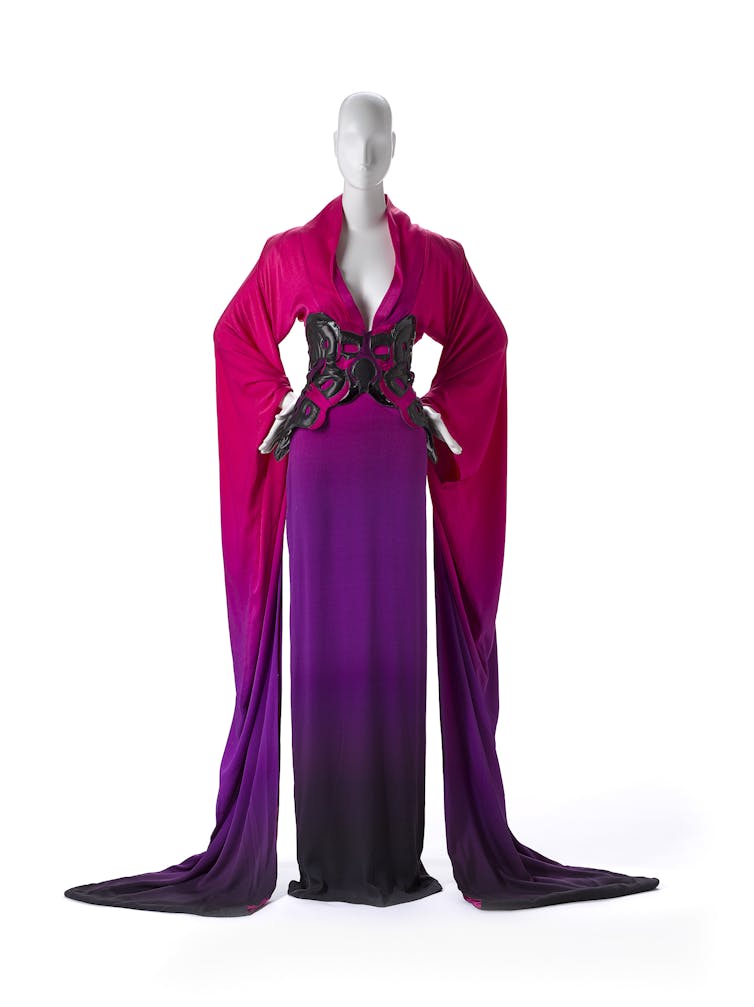
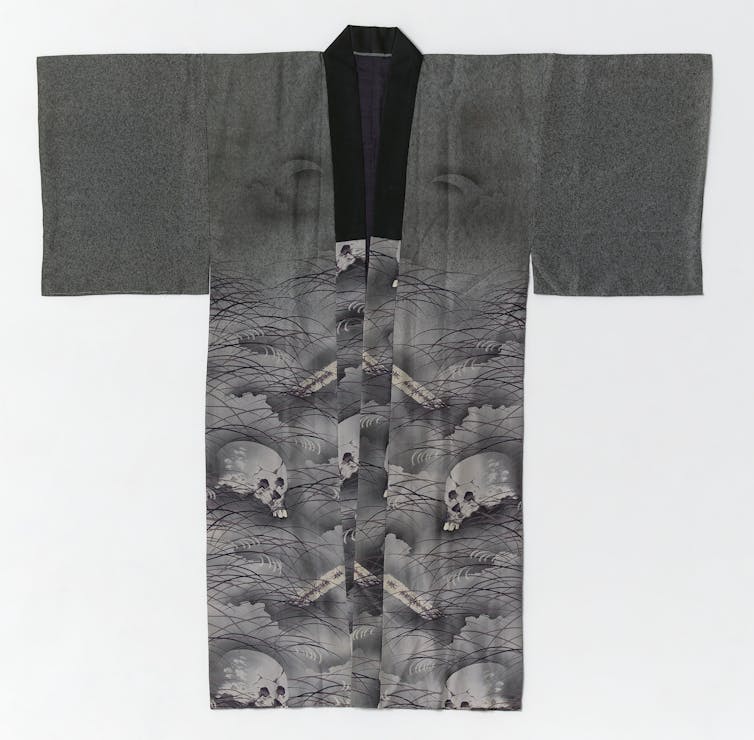
![]()




